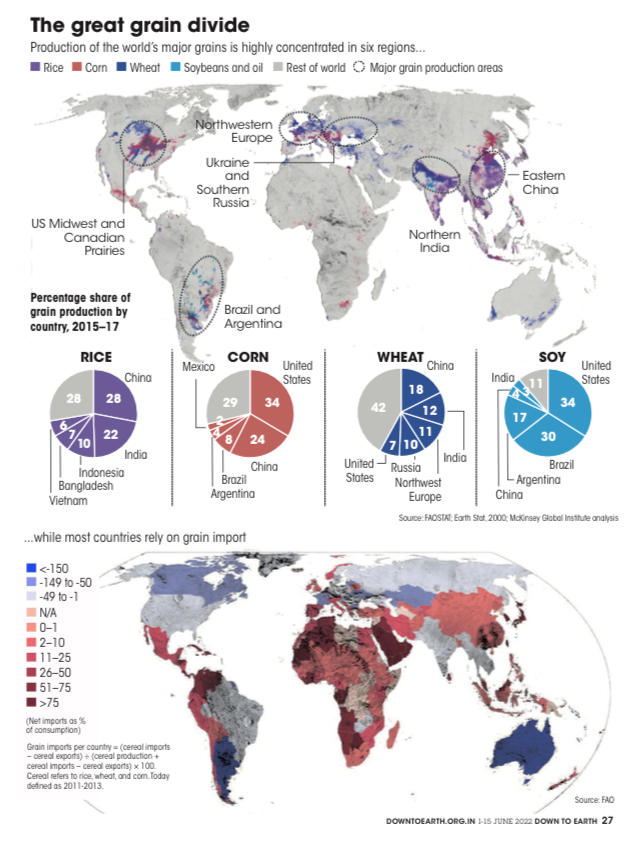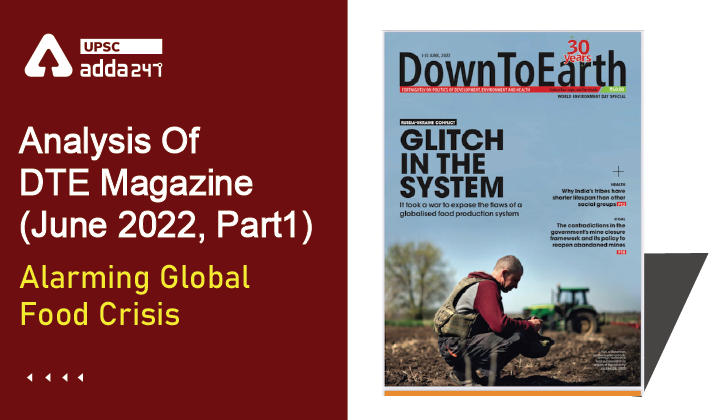Table of Contents
Introduction
- Since the Russian invasion of Ukraine on February 24, the number of countries imposing export restrictions on food has risen from three to 17.
- Current trade restrictions due to the war affect nearly 36 per cent of wheat exports, 55 per cent of palm oil, 17.2 per cent of corn, 78.2 per cent of sunflower oil exports, and 5.8 per cent of soybean oil.
- On May 5, the government of India also stopped wheat purchase from Punjab, procuring only 56 per cent of its target of 44 million tonnes. When the wheat stock dwindled, the government replaced 5.5 million tonnes of wheat with rice for its pandemic relief programme, the Pradhan Mantri Garib Kalyan Yojana.
Importance Of Black Sea Region For Global Food Chain
- The Black Sea region, which includes Russia, Ukraine and Kazakhstan, is one of the world’s six food baskets.
- Russia is the world’s largest wheat exporter while Ukraine is sixth on the list.
- Together, the two warring countries produce 12 per cent of all food calories traded globally; control 29 per cent of global wheat exports, 19 per cent of maize exports, and 78 per cent of sunflower oil exports.
- Russia is also the world’s top exporter of nitrogen fertilisers, the second leading supplier of potassium fertilisers and the third largest exporter of phosphorus fertilisers.
- Some 50 countries depend on Russia-Ukraine for their food supply, particularly for wheat, maize and sunflower oils.
- The majority of these are poor and import-dependent countries in Asia and Africa. Of the 53 countries or ter- ritories that faced food crisis last year, 36 depended on Ukrainian and Russian exports for more t han 10 per cent of their total wheat imports, as per an analysis by Washington DC-based International Food Policy Research Institute (ifpri).
- In terms of food supply, in 2019 wheat and wheat products represented 408 kilocalories per capita per day in the countries facing food crisis.
- In east Africa, where wheat and wheat products account for a third of the average cereal consumption, 90 per cent of the wheat imports come from Russia and Ukraine, as per UN’s World Food Programme (wfp).

Three Dimensional Crisis
- A preliminary assessment by the UN Task Team for the Global Crisis Response Group says the war has led to a “three-dimensional” crisis—rising food prices, rising energy prices and tightening finance.
- Some 1.7 billion people in 107 countries (41 in Africa, 38 in Asia and the Pacific and 28 in Latin America and the Caribbean) are exposed to at least one of the dimension.
- Some 69 economies with 1.2 billion of the world’s people are “severely or significantly” exposed to the three-dimensional crisis.
- Consequently, thousands of kilometres from the war zone, some 70 per cent of Africa’s economies are at risk of collapsing, putting millions on the verge of food scarcity.
- Egypt, for instance, depends on Ukraine and Russia for 60 per cent of its food imports. Its food inflation rose to 26 per cent in April.
- Angola—a country that does not produce wheat traditionally but consumes 0.65 million tonnes of it annually—meets 30 per cent of its demands from Russia-Ukraine. With the war curbing supply, wheat price at the consumer level has increased by 40 per cent.
- Lebanon, a country that has not registered growth in the last four years, sources up to 25 per cent of its average calorie consumption from wheat and sunflower oil imported from Russia-Ukraine.
Uncertainties in Near Future
- In the immediate future, the overall global availability of foodgrains will be further reduced.
- The rise in prices of energy and fertilisers is likely to reduce yield, as per ifpri’s report.
- The fertiliser shortfall comes at the start of planting seasons in many countries, including India.
- As countries substitute the commodities that are in short supply with others, the prices of the substitutes will go up. For example, rice is being used to fill the gap in cereal imports, and its price has increased by 12 per cent globally since the beginning of the year.
- As countries start sourcing food, fuel and fertilisers from countries other than Russia and Ukraine, it will add to the overall costs, ultimately adding to the cost of the produce.
Conclusion
The current crisis has shown us the true character of a “globalised world” with countries already resorting to hoarding staple foods that till recently exported for profits.



 TSPSC Group 1 Question Paper 2024, Downl...
TSPSC Group 1 Question Paper 2024, Downl...
 TSPSC Group 1 Answer key 2024 Out, Downl...
TSPSC Group 1 Answer key 2024 Out, Downl...
 UPSC Prelims 2024 Question Paper, Downlo...
UPSC Prelims 2024 Question Paper, Downlo...




